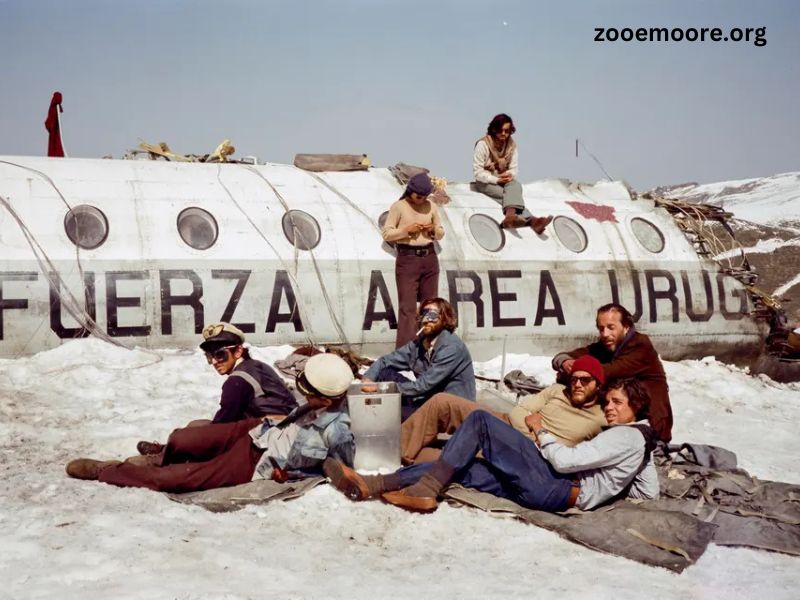The Society of the Snow, a gripping tale of survival and resilience, draws inspiration from the harrowing true events of the 1972 Andes plane crash. When the Uruguayan Air Force Flight 571 went down in the remote mountains, it set off an extraordinary series of events that tested the limits of human endurance and morality. While many are familiar with the narrative through books and films, the real photographs from the rescue efforts and the survivors offer a haunting glimpse into their ordeal.
The Incident
On October 13, 1972, a chartered Fairchild FH-227D aircraft carrying 45 passengers, including members of a Uruguayan rugby team, their friends, and family, crashed into the Andes during a flight from Montevideo to Santiago. The initial impact resulted in the deaths of many passengers, while the survivors faced a harsh reality in the freezing wilderness.
The survivors quickly realized that rescue would not come swiftly. The mountainous terrain was treacherous, and bad weather hindered search efforts. After days without food and with dwindling hope, the group was forced to confront an unimaginable decision: to survive, they would need to resort to cannibalism.
The Struggle for Survival
The photos from this period are stark and poignant. They capture the harsh conditions the survivors faced—snow-covered mountains, makeshift shelters, and the faces of those who endured extreme hardship. One particularly haunting image shows the remnants of the aircraft, a stark reminder of the tragedy. In the background, the vastness of the Andes looms, emphasizing their isolation.
As days turned into weeks, the survivors struggled against the elements. They salvaged what they could from the wreckage, using pieces of the plane for shelter and warmth. The images from this period often depict the survivors huddled together for warmth, their expressions reflecting both despair and determination.
The Decision to Cannibalize
One of the most controversial aspects of their survival was the decision to consume the bodies of those who had died in the crash. This choice, often met with disbelief by those outside the situation, was a desperate measure to stay alive. The photographs from this time reveal the gravity of their circumstances, showing individuals who were once vibrant athletes now emaciated and gaunt.
These images do not shy away from the stark reality of survival; they convey a sense of loss and ethical turmoil. The survivors have recounted their experiences in various interviews and documentaries, discussing how this decision weighed heavily on them, both then and now. The photos serve as a powerful reminder of the ethical dilemmas faced in life-and-death situations.
The Rescue Efforts
After 72 days stranded in the mountains, the survivors were finally located. A search effort had been initiated, but it was a hiker who inadvertently discovered them. The first photographs of the rescue show the survivors, barely recognizable after weeks of starvation and exposure. Their joy at being found is palpable, but so too is the toll that the ordeal has taken on them.
These images contrast sharply with earlier photos from the crash site, highlighting the transformation of the survivors from hopeful individuals to ones marked by trauma. The photographs of their rescue depict a mix of relief and lingering grief, as many of their friends had not survived.
The Aftermath
In the years following the rescue, the survivors struggled to reintegrate into society. Many faced psychological challenges, grappling with the trauma of their experiences and the moral implications of their survival. The photos that emerged in the aftermath often depict survivors reflecting on their ordeal, now as advocates for mental health awareness and the importance of community support.
Public interest in their story has led to various retellings, including the 1993 film “Alive” and numerous documentaries. However, the real photos of the survivors tell a more intimate story, capturing moments of vulnerability, resilience, and healing. They serve as a testament to the enduring spirit of those who lived through one of the most remarkable survival stories in history.
Legacy and Reflection
The legacy of the Society of the Snow extends beyond the tragedy itself. It has sparked discussions about human nature, ethics, and survival. The photographs from this chapter of history evoke powerful emotions and prompt us to reflect on what we might do in similar circumstances.
In recent years, many of the survivors have come forward to share their stories, participating in interviews, writing books, and giving talks about their experiences. These real photos, combined with their narratives, help to humanize the story, allowing others to connect with the profound complexities of their ordeal.
Conclusion
The Society of the Snow stands as a haunting reminder of the fragility of life and the strength of the human spirit. The real photographs from this story capture the raw emotions of survival, loss, and resilience. They are not just images; they are a testament to the choices that individuals make in the face of unimaginable circumstances.
As we reflect on this story, it’s essential to remember the individuals behind the images—those who faced the ultimate test of endurance and emerged with a story that continues to resonate today. Their legacy invites us to contemplate the depths of human endurance, the moral complexities of survival, and the unbreakable bonds of community forged in the most desperate of times.



